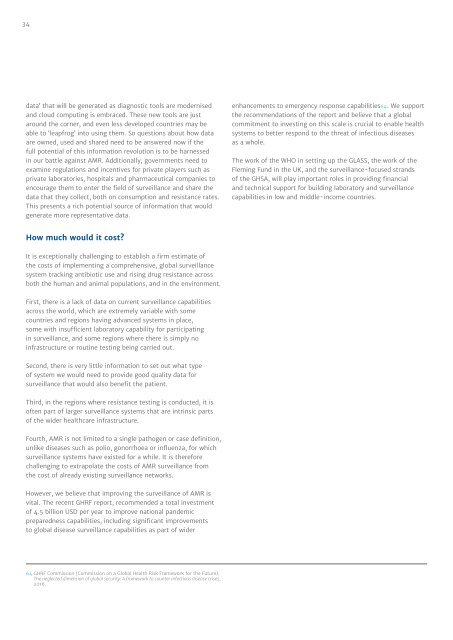TACKLING DRUG-RESISTANT INFECTIONS GLOBALLY FINAL REPORT AND RECOMMENDATIONS
qQvJ300ETXu
qQvJ300ETXu
Create successful ePaper yourself
Turn your PDF publications into a flip-book with our unique Google optimized e-Paper software.
34<br />
data’ that will be generated as diagnostic tools are modernised<br />
and cloud computing is embraced. These new tools are just<br />
around the corner, and even less developed countries may be<br />
able to ‘leapfrog’ into using them. So questions about how data<br />
are owned, used and shared need to be answered now if the<br />
full potential of this information revolution is to be harnessed<br />
in our battle against AMR. Additionally, governments need to<br />
examine regulations and incentives for private players such as<br />
private laboratories, hospitals and pharmaceutical companies to<br />
encourage them to enter the field of surveillance and share the<br />
data that they collect, both on consumption and resistance rates.<br />
This presents a rich potential source of information that would<br />
generate more representative data.<br />
enhancements to emergency response capabilities64. We support<br />
the recommendations of the report and believe that a global<br />
commitment to investing on this scale is crucial to enable health<br />
systems to better respond to the threat of infectious diseases<br />
as a whole.<br />
The work of the WHO in setting up the GLASS, the work of the<br />
Fleming Fund in the UK, and the surveillance-focused strands<br />
of the GHSA, will play important roles in providing financial<br />
and technical support for building laboratory and surveillance<br />
capabilities in low and middle-income countries.<br />
How much would it cost?<br />
It is exceptionally challenging to establish a firm estimate of<br />
the costs of implementing a comprehensive, global surveillance<br />
system tracking antibiotic use and rising drug resistance across<br />
both the human and animal populations, and in the environment.<br />
First, there is a lack of data on current surveillance capabilities<br />
across the world, which are extremely variable with some<br />
countries and regions having advanced systems in place,<br />
some with insufficient laboratory capability for participating<br />
in surveillance, and some regions where there is simply no<br />
infrastructure or routine testing being carried out.<br />
Second, there is very little information to set out what type<br />
of system we would need to provide good quality data for<br />
surveillance that would also benefit the patient.<br />
Third, in the regions where resistance testing is conducted, it is<br />
often part of larger surveillance systems that are intrinsic parts<br />
of the wider healthcare infrastructure.<br />
Fourth, AMR is not limited to a single pathogen or case definition,<br />
unlike diseases such as polio, gonorrhoea or influenza, for which<br />
surveillance systems have existed for a while. It is therefore<br />
challenging to extrapolate the costs of AMR surveillance from<br />
the cost of already existing surveillance networks.<br />
However, we believe that improving the surveillance of AMR is<br />
vital. The recent GHRF report, recommended a total investment<br />
of 4.5 billion USD per year to improve national pandemic<br />
preparedness capabilities, including significant improvements<br />
to global disease surveillance capabilities as part of wider<br />
64 GHRF Commission (Commission on a Global Health Risk Framework for the Future).<br />
The neglected dimension of global security: A framework to counter infectious disease crises,<br />
2016.


